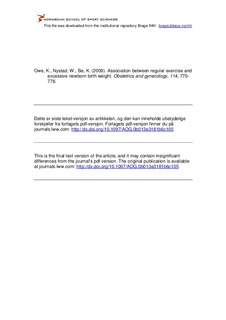| dc.contributor.author | Owe, Katrine M. | |
| dc.contributor.author | Nystad, Wenche | |
| dc.contributor.author | Bø, Kari | |
| dc.date.accessioned | 2010-11-04T14:16:19Z | |
| dc.date.available | 2010-11-04T14:16:19Z | |
| dc.date.issued | 2009-10 | |
| dc.identifier | Seksjon for idrettsmedisinske fag / Department of Sports Medicine | |
| dc.identifier.citation | Obstetrics and Gynecology. 2009, 114(4), 770-776 | en_US |
| dc.identifier.issn | 0029-7844 | |
| dc.identifier.uri | http://hdl.handle.net/11250/170573 | |
| dc.description | I Brage finner du siste tekst-versjon av artikkelen, og den kan inneholde ubetydelige forskjeller fra forlagets pdf-versjon. Forlagets pdf-versjon finner du på journals.lww.com: http://dx.doi.org/10.1097/AOG.0b013e3181b6c105 / In Brage you'll find the final text version of the article, and it may contain insignificant differences from the journal's pdf version. The original publication is available at journals.lww.com: http://dx.doi.org/10.1097/AOG.0b013e3181b6c105 | en_US |
| dc.description.abstract | OBJECTIVE: To estimate the association between regular exercise before and during pregnancy and excessive newborn birth weight.
METHODS: Using data from the Norwegian Mother and Child Cohort Study, 36,869 singleton pregnancies lasting at least 37 weeks were included. Information on regular exercise was based on answers from two questionnaires distributed in pregnancy weeks 17 and 30. Linkage to the Medical Birth Registry of Norway provided data on newborn birth weight. The main outcome measure was excessive newborn birth weight, defined as birth weight at or above the 90th percentile. Logistic regression analyses were used to estimate the associations separately for nulliparous (n=16,064) and multiparous (n=20,805) women, and the results are presented as adjusted odds ratios (aORs) with 95% confidence intervals (95% CIs).
RESULTS: Excessive newborn birth weight was observed in 4,033 (10.9%) newborns, 56.1% (n=2,263) of whom were born to multiparous women. An inverse association between regular exercise (at least three times per week) and excessive newborn birth weight in pregnancy weeks 17 and 30 was observed in nulliparous women, aOR 0.72 (95% CI 0.56-0.93) and aOR 0.77 (95% CI 0.61-0.96), respectively. Regular exercise performed before pregnancy did not affect the probability of delivering newborns with an excessive birth weight in nulliparous or multiparous women.
CONCLUSION: Regular exercise during pregnancy reduces the odds of giving birth to newborns with excessive birth weight by 23-28%. | en_US |
| dc.language.iso | eng | en_US |
| dc.publisher | LWW | en_US |
| dc.subject | birth weight | en_US |
| dc.subject | cohort studies | en_US |
| dc.subject | physical activity | en_US |
| dc.subject | pregnancy | en_US |
| dc.subject | regular exercise | en_US |
| dc.title | Association between regular exercise and excessive newborn birth weight | en_US |
| dc.type | Journal article | en_US |
| dc.type | Peer reviewed | en_US |
| dc.subject.nsi | VDP::Medical disciplines: 700 | en_US |
| dc.source.pagenumber | 770-776 | en_US |
